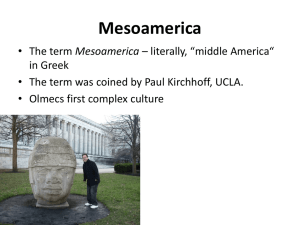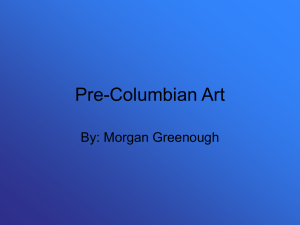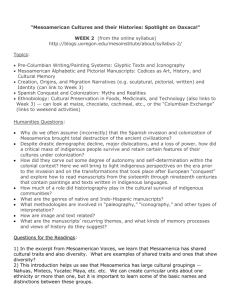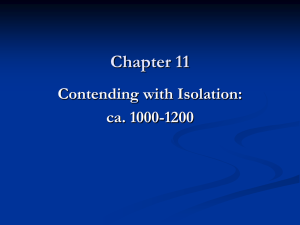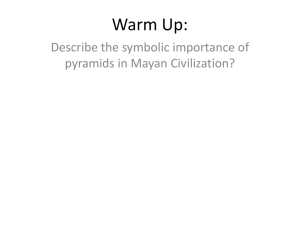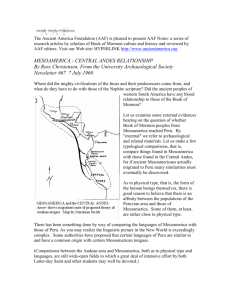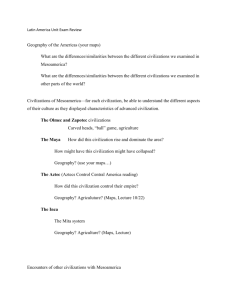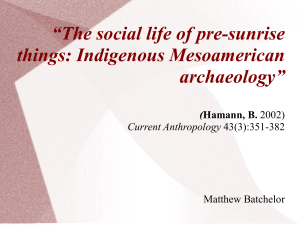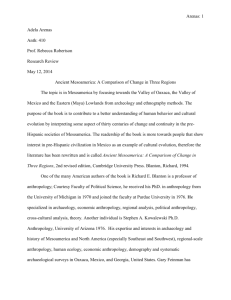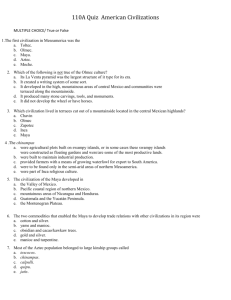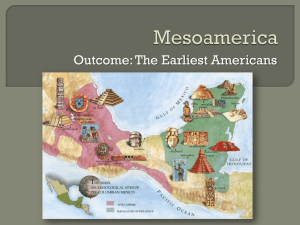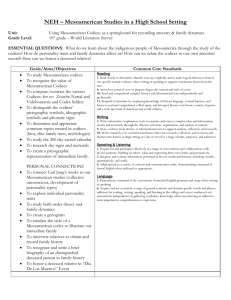NEH – Mesoamerican Studies in a High School Setting
advertisement
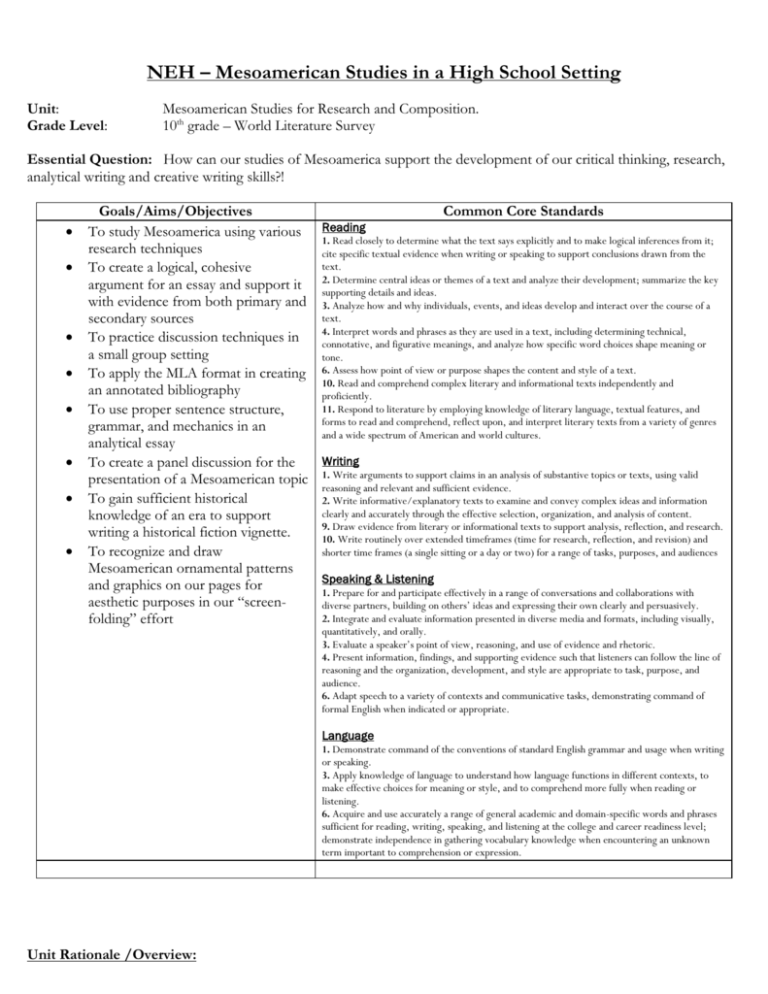
NEH – Mesoamerican Studies in a High School Setting Unit: Grade Level: Mesoamerican Studies for Research and Composition. 10th grade – World Literature Survey Essential Question: How can our studies of Mesoamerica support the development of our critical thinking, research, analytical writing and creative writing skills?! Goals/Aims/Objectives Common Core Standards Reading To study Mesoamerica using various 1. Read closely to determine what the text says explicitly and to make logical inferences from it; research techniques cite specific textual evidence when writing or speaking to support conclusions drawn from the text. To create a logical, cohesive Determine central ideas or themes of a text and analyze their development; summarize the key argument for an essay and support it 2. supporting details and ideas. with evidence from both primary and 3. Analyze how and why individuals, events, and ideas develop and interact over the course of a text. secondary sources 4. Interpret words and phrases as they are used in a text, including determining technical, To practice discussion techniques in connotative, and figurative meanings, and analyze how specific word choices shape meaning or a small group setting tone. To apply the MLA format in creating 6. Assess how point of view or purpose shapes the content and style of a text. 10. Read and comprehend complex literary and informational texts independently and an annotated bibliography proficiently. 11. Respond to literature by employing knowledge of literary language, textual features, and To use proper sentence structure, forms to read and comprehend, reflect upon, and interpret literary texts from a variety of genres grammar, and mechanics in an and a wide spectrum of American and world cultures. analytical essay Writing To create a panel discussion for the Write arguments to support claims in an analysis of substantive topics or texts, using valid presentation of a Mesoamerican topic 1. reasoning and relevant and sufficient evidence. To gain sufficient historical 2. Write informative/explanatory texts to examine and convey complex ideas and information clearly and accurately through the effective selection, organization, and analysis of content. knowledge of an era to support 9. Draw evidence from literary or informational texts to support analysis, reflection, and research. writing a historical fiction vignette. 10. Write routinely over extended timeframes (time for research, reflection, and revision) and To recognize and draw shorter time frames (a single sitting or a day or two) for a range of tasks, purposes, and audiences Mesoamerican ornamental patterns Speaking & Listening and graphics on our pages for 1. Prepare for and participate effectively in a range of conversations and collaborations with aesthetic purposes in our “screendiverse partners, building on others’ ideas and expressing their own clearly and persuasively. 2. Integrate and evaluate information presented in diverse media and formats, including visually, folding” effort quantitatively, and orally. 3. Evaluate a speaker’s point of view, reasoning, and use of evidence and rhetoric. 4. Present information, findings, and supporting evidence such that listeners can follow the line of reasoning and the organization, development, and style are appropriate to task, purpose, and audience. 6. Adapt speech to a variety of contexts and communicative tasks, demonstrating command of formal English when indicated or appropriate. Language 1. Demonstrate command of the conventions of standard English grammar and usage when writing or speaking. 3. Apply knowledge of language to understand how language functions in different contexts, to make effective choices for meaning or style, and to comprehend more fully when reading or listening. 6. Acquire and use accurately a range of general academic and domain-specific words and phrases sufficient for reading, writing, speaking, and listening at the college and career readiness level; demonstrate independence in gathering vocabulary knowledge when encountering an unknown term important to comprehension or expression. Unit Rationale /Overview: This unit satisfies the sophomore research project requirement in my World Literature Course. In addition to research skills, this unit develops critical thinking skills, public-speaking skills and composition skills. It closely examines Mesoamerica using various lenses and themes for research. Overall, students develop essential skills and develop an appreciation for Mesoamerican history and culture. Through a multi-modal class lens and access to extensive historical and cultural research, students learn about the magnificence of Mesoamerica and use that knowledge for creative expression. In this unit, students first learn how to create / develop research questions around a general topic. Then they are divided into teams where they develop research questions about Mesoamerica. After preliminary research, students finalize research topics, and brainstorm ideas for thesis statements. These will guide their research and the development of their essays and annotated bibliographies. Students are introduced to the school library databases and classroom library texts and taught how to navigate these resources to support their essays with the required textual evidence. Students are also provided with instruction in creating the annotated bibliography. Students meet several times during the research process to discuss findings and get feedback on work. On the first essay due date, students participate in a peer evaluation workshop where they peer-edit essays and annotated bibliographies and provide each other with critical feedback for the revision process. Students are then allowed to take home the work and revise it based on peer feedback using a rubric before final submission date. Meanwhile, in their groups, students create a panel discussion which serves as a presentation for the class. Here, students synthesize the information in the individual essays and find an effective yet creative way to present their findings to the class. For the final unit assignment, students use all of their historical knowledge of Mesoamerica and intertwine it with their imagination to create a vignette of historical fiction. While this is an individual creative piece, the class will attempt to string together this potpourri of vignettes in the screen-fold style of a Mesoamerican Codex! _____________________________________________________________________________________________ Experiential Learning: These are offered as extra credit assignments but students are strongly encouraged to go in groups or with their families. Go to one of New York City’s public libraries and read a book that is only available for reference in the library. Go to the Brooklyn Museum to see their Mesoamerica holdings. (There is one informal after-school trip scheduled). Sequence #1 1 How do we generate authentic research questions? 2 How do we examine a topic from various lenses? 3 Students are taught how to create / develop questions around a general topic using various lenses. 4: Lenses & Themes are: Environmental, Scientific, Economic, Political / Historical, Cultural / Social, Artistic / Philosophical, Ethical, Futuristic 5 Students are given an example of a topic developed through various lenses. (see below) 6 Students practice in groups with topics: Revolution! Democracy, etc. Sequence #2 1 Students are divided into research teams 2 How can we examine Mesoamerica using various lenses? (Students meet for two consecutive classes to develop research questions for Mesoamerica. Students chart their work on a giant post-it.) 3 How can we access information about Mesoamerica using databases available through the BTHS library? 4 How do we access the New York Public Library’s holdings using MyLibrary account? 5 How do we write annotations for an annotated bibliography? Sequence #3 1 How do we use the rubric as the essay writing guideline? 2 Team meeting #1 – Students discuss findings and using the rubric to organize the essay. 3 Team meeting #2 – Students provide feedback to the essay’s first draft. 4 Teacher provides orientation / guideline to creating a panel discussion. 5 Team meeting #3 – Students admire finished products and discuss the particulars of panel discussion. 6 Team meeting #4 – Students meet for the last time before panel discussions begin in class. 7 All research teams present – Panel discussions. Sequence #4 1 All students read: John Pohl’s The Legend of Eight Deer. And read short biographies of important historical figures. And watch a film that depicts Mesoamerica. 2 What is historical fiction? Why is thorough knowledge of an era essential in creating a work of historical fiction? 3 What is a vignette? What are its distinguishing features? 4 In groups of 3 or 4, students brainstorm ideas for the vignettes – What are the possible historical periods? Who are the possible characters? Who are the possible cultural groups? What are the possible geographical areas? What are the possible settings? What are the possible events? 5 In informal groups, students are encouraged to share ideas for vignettes. Students are encouraged to visit other groups to get details about the vignettes in creation mode. The idea here is that students group themselves up to keep the narrative going over the course of a few vignettes. 6 Individually, students create a historical fiction vignette. 7 Students will “string” some narratives together to illustrate the fragmented nature of what we know today as Mesoamerican history. 8 Students find a way to “screen-fold” vignettes together for display!!!!! TOPICS AND RESEARCH QUESTIONS: The following is a list of lenses / topics and research questions that the teacher can have on hand to provide examples to students as they work in groups to develop a research angle and develop a thesis. Topic 1 – Political - Historical / Conquest: How did the Spanish Conquistadores establish and maintain rule in Mesoamerica? What were the reactions of the indigenous people? Topic 2 – Cultural – Social / Religion: How did the indigenous people in Mesoamerica adapt to the imposition of Catholicism? What were the religious practices of the pre-Hispanic indigenous people? Topic 3 – Environmental / Geography: How did environmental resources in Mesoamerica affect the Spanish colonization of this area? Topic 4 – Historical-Political / Archaeology: What do archaeological studies / sites reveal about the indigenous people of Mesoamerica? Topic 5 – Artistic-Philosophical / Art: What art forms have Mesoamericans used for cultural knowledge and preservation? Topic 6 – Cultural – Social /Language: How have the indigenous people of Mesoamerica endured and surpassed the challenges of language preservation? Topic 7 – Environmental / Agriculture: What is the history of corn domestication in Mesoamerica and what are the implications? Topic 8 – Scientific / Disease: How did disease affect the indigenous people of Mesoamerica during the 16th century? Topic 9 – Ethical / Religion: How did the Spanish impose Christianity on the indigenous people of Mesoamerica? Topic 10 – Ethical / Rituals: What role did sacrifice play in the life of the Mesoamericans? Developing questions from various lenses: Examples for review Even with a topic as general as “environment”, this type of inquiry works! TOPIC: ENVIRONMENT Cultural / Social Artistic / Philosophical Ethical Political / Historical Economic How do our identities create / dictate our environment? How do different societies view / respond to environmental change? How does living in the contemporary world affect our depictions of nature? Is the developed world obligated to help third world nations with their environmental problems? Can we “own” natural resources? How are heated debates about the environment tied to world politics? What benefits does the developing world get from having the developed world use its resources? Now let’s try another general topic? TOPIC: DEMOCRACY Ethical Should criminals have the right to vote? Historical / Political Where do democratic ideals have their origin? Economic How does the democratic state affect the economy? Art / Philosophical How have democratic ideals from around the world, inspired great works of art? How does a democratic government affect the efforts of the scientific research community? Scientific Now let’s try one together! TOPIC: Mesoamerica – Classroom Resources: Adams, Richard. Prehistoric Mesoamerica. University of Oklahoma Press. Norman, 1977. Carrasco, David., Lindsay Jones & Scott Sessions. Eds., Mesoamerica’s Classic Heritage: From Teotihuacan to the Aztecs. University Press of Colorado, Boulder, 2000. Hill Boone, Elizabeth. Stories in Red and Black: Pictorial Histories of the Aztecs and Mixtecs. University of Texas Press. Austin, 2000. Keenan, Sheila. Ed. Gods, Goddesses and Monsters: A Book of World Mythology. Scholastic Inc., New York, 2000. Phillips, Charles. The Complete Illustrated History: Aztec & Maya. Metro Books. New York, 2014. Pohl, John. The Legend of Lord Eight Deer: An Epic of Ancient Mexico. Oxford University Press. Oxford, 2002. Pohl, John. Exploring Mesoamerica – Places in Time Series. Oxford University Press. New York, 1999. Restall, Matthew. Maya Conquistador. Beacon Press, Boston, 1998. Stephen, Lynn. Zapotec Women. University of Texas Press. Austin, 1991. Tavarez, David. The Invisible War: Indigenous Devotions, Discipline, and Dissent in Colonial Mexico. Stanford University Press, Stanford, 2011. Whitecotton, Joseph. The Zapotecs: Prines, Priests & Peasants. Univwersity of Oklahoma Press, Norman, 1977.
